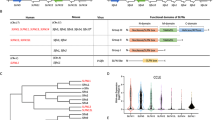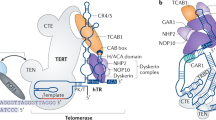Abstract
By serological screening of a breast tumor cDNA library we have identified a novel human gene, tnkl, encoding an ankyrin-related protein with a high degree of similarity to tankyrase, the poly(ADP-ribose)polymerase associated with human telomeres (Smith et al, Science 282: 1484). The tnkl gene maps to chromosome 10, while the tnks gene encoding tankyrase is located on chromosome 8. The predicted 1166-aa protein product of the tnkl gene is 78% identical to human tankyrase and 62% to a putative D. melanogaster protein. Since the proteins have essentially identical domain structures, the corresponding genes form a distinct gene family. The possible link between TNKL and cancer justifies its further functional analysis.
This is a preview of subscription content, access via your institution
Access options
Subscribe to this journal
Receive 6 digital issues and online access to articles
$119.00 per year
only $19.83 per issue
Buy this article
- Purchase on Springer Link
- Instant access to full article PDF
Prices may be subject to local taxes which are calculated during checkout
Similar content being viewed by others
Author information
Authors and Affiliations
Corresponding author
Additional information
This project has been funded by the Ludwig Institute for Cancer Research, and by grants 00-04-48300 (ANK) and 98-04-49031 (MAL) from the Russian Foundation for Basic Research.
Rights and permissions
About this article
Cite this article
Kuimov, A., Kuprash, D., Petrov, V. et al. Cloning and characterization of TNKL, a member of tankyrase gene family . Genes Immun 2, 52–55 (2001). https://doi.org/10.1038/sj.gene.6363722
Published:
Issue Date:
DOI: https://doi.org/10.1038/sj.gene.6363722
Keywords
This article is cited by
-
Poly(ADP-ribosyl)ation of mannose-binding lectin out of human kidney cells
Molecular and Cellular Biochemistry (2011)
-
Human tankyrases are aberrantly expressed in colon tumors and contain multiple epitopes that induce humoral and cellular immune responses in cancer patients
Cancer Immunology, Immunotherapy (2008)
-
Immunohistochemical detection of tankyrase 2 in human breast tumors and normal renal tissue
Cell and Tissue Research (2006)



